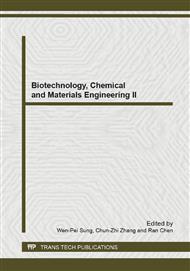p.744
p.748
p.752
p.756
p.760
p.765
p.769
p.773
p.777
Expression of Aminolevulinate Dehydratase during Mycelium Development in Monascus purpureus
Abstract:
During the initial steps of porphyrins biosynthesis, two molecules of 5-aminolevulinic acid are asymmetrically condensed to porphobilinogen by aminolevulinate dehydratase (ALAD). To investigate the relationship between the mycelium development and gene expression for ALAD in Monascus purpureus, the cDNA coding for ALAD of M.purpureus was isolated. The recombinant ALAD protein was expressed in E. coli BL21 (DE3) cells and subsequently purified using affinity chromatography. We analyzed the phylogenetic variation in metal ion usage by ALAD enzymes, and suggested that MpALAD utilize zinc to act in catalytic site. Transcriptional expression of MpALAD during M.purpureus liquid cultivation process was assayed by RT-PCR analysis on mycelium at two distinct development stages. With the transition of mycelium color from white to red, a decrease in the transcript level for MpALAD gene was observed. The results revealed that the transcriptional expression of MpALAD is developmentally regulated in M.purpureus.
Info:
Periodical:
Pages:
760-764
Citation:
Online since:
January 2013
Price:
Сopyright:
© 2013 Trans Tech Publications Ltd. All Rights Reserved
Share:
Citation:


